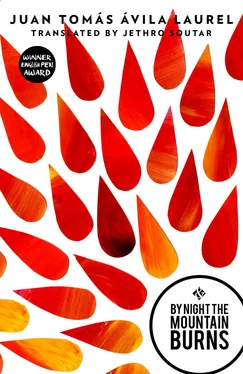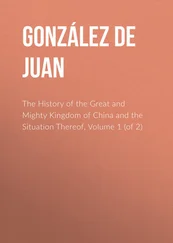Juan Ávila Laurel - By Night the Mountain Burns
Здесь есть возможность читать онлайн «Juan Ávila Laurel - By Night the Mountain Burns» весь текст электронной книги совершенно бесплатно (целиком полную версию без сокращений). В некоторых случаях можно слушать аудио, скачать через торрент в формате fb2 и присутствует краткое содержание. Год выпуска: 2014, Издательство: And Other Stories Publishing, Жанр: Современная проза, на английском языке. Описание произведения, (предисловие) а так же отзывы посетителей доступны на портале библиотеки ЛибКат.
- Название:By Night the Mountain Burns
- Автор:
- Издательство:And Other Stories Publishing
- Жанр:
- Год:2014
- ISBN:нет данных
- Рейтинг книги:5 / 5. Голосов: 1
-
Избранное:Добавить в избранное
- Отзывы:
-
Ваша оценка:
- 100
- 1
- 2
- 3
- 4
- 5
By Night the Mountain Burns: краткое содержание, описание и аннотация
Предлагаем к чтению аннотацию, описание, краткое содержание или предисловие (зависит от того, что написал сам автор книги «By Night the Mountain Burns»). Если вы не нашли необходимую информацию о книге — напишите в комментариях, мы постараемся отыскать её.
By Night the Mountain Burns — читать онлайн бесплатно полную книгу (весь текст) целиком
Ниже представлен текст книги, разбитый по страницам. Система сохранения места последней прочитанной страницы, позволяет с удобством читать онлайн бесплатно книгу «By Night the Mountain Burns», без необходимости каждый раз заново искать на чём Вы остановились. Поставьте закладку, и сможете в любой момент перейти на страницу, на которой закончили чтение.
Интервал:
Закладка:
Juan Tomás Ávila Laurel
By Night the Mountain Burns
By Night the Mountain Burns
The song goes like this:
Maestro: Aaale, toma suguewa,
All: Alewa!
Maestro: Aaaalee, toma suguewa,
All: Alewa!
The ‘toma suguewa’ part means ‘give it a pull’, but it also means ‘will you give it a pull’, or ‘will you all give it a pull’, even ‘will sir give it a pull’. Know why it can be any of these things? Because in the language the song is sung, my island’s language, there is no polite form of address like there is in Spanish. Nevertheless, the maestro treats everyone with respect, as if he’s addressing them as ‘sir’, and because he asks them so respectfully, they pull. He does it all singing, and it’s a song that brings back many memories and fills me with nostalgia. As far as I’m concerned, it’s the most beautiful song in the world.
Aaale, toma suguewa,
Alewa!
Aaaalee, toma suguewa,
Alewa!
No, there are no other words to the song, no more verses. That’s it. The song consists of what the maestro asks, sung in a beautiful voice, and what the people say in reply, as they answer his call: Alewa! Then all together, as one, they pull what they’ve been asked — with due respect — to pull.
Does anybody know what they’re pulling? It’s something that happens on my island, which is located just below the equator. If I’d studied geography, I’d give degrees of latitude and longitude, so that you might look the island up on a map, or on some other more modern means of looking for things. In any case, I should mention that the island is African and that the people who live on the island are black, every last one of them. And that it’s surrounded by the Atlantic Ocean. Totally surrounded. The black people I speak of live on a sliver of land that pokes out of the murky waters.
And what of the simple but meaningful song? The inhabitants of the island live from fishing, a fishing that’s done almost entirely by hand out at sea. And in order to get out to sea the fishermen paddle flimsy canoes. These canoes are made out of tree trunks, cut from trees that are known to be good for floating. There are only three types of tree on the island that can be used for making canoes, only three.
Does anyone know how you start when making a canoe? First you select the tree, and if it’s not your tree but a tree on a woman’s plantation, women being the ones who farm on the island, you go and speak to her. You might be lucky and she’s a widow or has no husband, or she has one but he’s away. Or you might be unlucky and she has sons who are growing up, and she knows that one day the tree will make a good canoe for those sons, when they’re old enough to go out fishing and transport things about the island. Every man on our Atlantic Ocean island has his own canoe, and if he doesn’t have one, a new canoe is brought into the world so that he does, so that nobody on the island has to borrow one from anyone else.
If you manage to do a deal with the woman, or if it turns out that your own woman has one of the three types of trees on her farmland, you cut through it until it falls to the ground where you found it. This last part is worth mentioning because if the land happens to be planted, it’s going to be very difficult to get the woman to agree to your cutting the tree down, even if you offer her something of equivalent value in exchange.
After chopping off the branches and piling them up to be used as firewood once they’re dry, you’re ready to call upon whoever you consider the best craftsman, so that he might start work on your canoe. It’s important that you pay him a visit and that he accepts the invitation. He, the maestro, won’t ask you for anything impossible in return, nothing that will cause you to look to the heavens. Normally he won’t ask you for anything at all and it will simply be enough that you show him respect, but if he does ask you for something, it will be something readily to hand. He might ask for a drink, a drink that everyone has or can get hold of, or he might ask for a favour in return. He might say to you, without lifting his voice or showing much concern, that you could clear some land for his wife, for she’s found an empty plot where she’d like to plant malanga and plantain. So anyway, you come to an agreement, and as soon as he can the maestro starts work on your canoe. The first job is the hardest job: hollowing out the trunk. This means digging the wood out so there’s enough depth and space for you and your wife, your little children and the load you’ll be carrying when you paddle from one part of the island to another. The hollowing out of the trunk is done right where the tree falls, the tree that will become your best friend, your right-hand man. The dug-out chunks of wood are gathered up by boys and girls and some older ladies, for they know a big tree gives a lot of itself. They collect the bark too, and when these chunks of wood and strips of bark are dry, they put them to burn in the stone tripod of the fireside, where the pot boils with things to eat, whatever there is.
The job of hollowing out the trunk is a hard one and it’s done using the heaviest kind of axe, an axe with a long handle. In truth it’s a job any strong young man can do, albeit with the guidance of the maestro, to make sure the youngster doesn’t overdo it and leave the canoe with too little walling. The trunk is only half-emptied at the place where the tree is felled, meaning the top side is cut into, the part that will become the inside of the canoe, and the edges are whittled down evenly, for they will become the sides of the canoe. The part that’s in contact with the ground is left alone for now. As the tree trunk is often longer than the canoe’s required length, another important job is to separate the canoe from the rest of the trunk. This job is a little more delicate than the hollowing out stage because through this process the front and back ends of the canoe emerge, the parts that distinguish the more striking and beautiful canoes, those made with real skill. One part, the front part, will have to break through the sea waters, and it will also be the part that’s seen when the charming little thing is beached after a day’s fishing. The back part supports whoever’s paddling the canoe, the helmsman, and it’s where he jumps on when he gets into the canoe and off when he reaches land.
Once these tasks are complete, most of the maestro’s work remains to be done and the canoe is still in the bush, where the tree was felled, a long way from the shore. It now has to be transported to the shore, where the maestro can finish his work close enough to the sea to hear the waves break, to taste them, and close enough for men to come and watch the work being done and comment on it. Only once it’s on the shore does the canoe really start to take shape, start to become a canoe that will be admired by all men and make the maestro proud. So that shell of a canoe has to be transported to the nearest feasible beach. The nearest and the most feasible. The double condition mustn’t be ignored because transporting the thing is hard, heavy work, and not every part of the coastline on our Atlantic Ocean island will welcome a canoe into its waters. Do not be fooled: there are certain shores on our island, some sandy, some stony, where the waves are angry and will not allow anyone into them in any kind of vessel, no matter what offering is made.
Does anyone know how you get the half-formed canoe to the shore from the bush it lies in? Some of you have guessed: by pulling it to its final destination, the bottom part dragging along the ground, which is why it’s left as it is, rugged and round. The owner of the canoe, he who asked for it to be built in the first place and who will use it for his needs, speaks to all his friends, and they in turn speak to their friends, and everyone agrees on a date when they will come and help pull the canoe to the shore. The owner knows there can never be too many hands. He also knows nobody will ask for anything in return, absolutely nothing for what is a hard job that takes a long time and uses up a lot of energy. So he also speaks to all the womenfolk he knows, especially the women who are his relatives, and he asks them for something too. He asks them to prepare, for the afternoon of the day of the pulling, a big pot of malanga soup, enough to feed all the people that will be needed to perform such an arduous task. This will be their only compensation and will send them home satisfied, energies restored, and safe in the knowledge that one day it will be their turn to call for the help of all noble men, and to ask their female nearest and dearest to prepare, for a particular hour of a particular afternoon, a restorative malanga soup.
Читать дальшеИнтервал:
Закладка:
Похожие книги на «By Night the Mountain Burns»
Представляем Вашему вниманию похожие книги на «By Night the Mountain Burns» списком для выбора. Мы отобрали схожую по названию и смыслу литературу в надежде предоставить читателям больше вариантов отыскать новые, интересные, ещё непрочитанные произведения.
Обсуждение, отзывы о книге «By Night the Mountain Burns» и просто собственные мнения читателей. Оставьте ваши комментарии, напишите, что Вы думаете о произведении, его смысле или главных героях. Укажите что конкретно понравилось, а что нет, и почему Вы так считаете.












